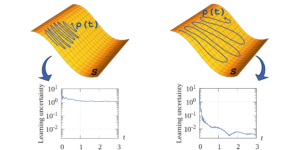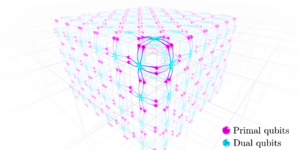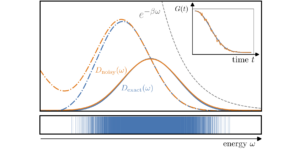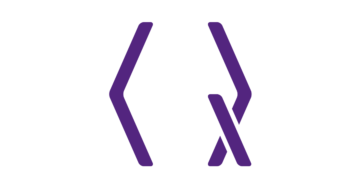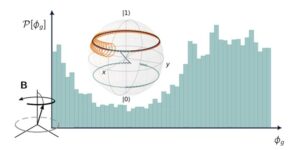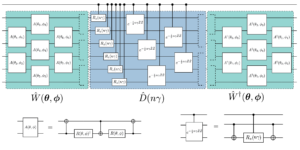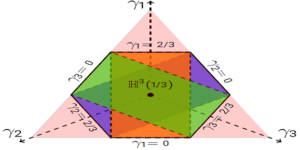1Duke Quantum Center, Duke University, Durham, NC 27701, USA
2Department of Electrical and Computer Engineering, Duke University, Durham, NC 27708 USA
3Sandia National Laboratories, Albuquerque, NM 87123, USA
4Quantum Information Science Section, Oak Ridge National Laboratory, Oak Ridge, TN 37831, USA
5Department of Physics and Astronomy, University of New Mexico, Albuquerque, NM 87131, USA
6Center for Quantum Information and Control, University of New Mexico, Albuquerque, NM 87131, USA
Find this paper interesting or want to discuss? Scite or leave a comment on SciRate.
Abstract
Quantum computing testbeds exhibit high-fidelity quantum control over small collections of qubits, enabling performance of precise, repeatable operations followed by measurements. Currently, these noisy intermediate-scale devices can support a sufficient number of sequential operations prior to decoherence such that near term algorithms can be performed with proximate accuracy (like chemical accuracy for quantum chemistry problems). While the results of these algorithms are imperfect, these imperfections can help bootstrap quantum computer testbed development. Demonstrations of these algorithms over the past few years, coupled with the idea that imperfect algorithm performance can be caused by several dominant noise sources in the quantum processor, which can be measured and calibrated during algorithm execution or in post-processing, has led to the use of noise mitigation to improve typical computational results. Conversely, benchmark algorithms coupled with noise mitigation can help diagnose the nature of the noise, whether systematic or purely random. Here, we outline the use of coherent noise mitigation techniques as a characterization tool in trapped-ion testbeds. We perform model-fitting of the noisy data to determine the noise source based on realistic physics focused noise models and demonstrate that systematic noise amplification coupled with error mitigation schemes provides useful data for noise model deduction. Further, in order to connect lower level noise model details with application specific performance of near term algorithms, we experimentally construct the loss landscape of a variational algorithm under various injected noise sources coupled with error mitigation techniques. This type of connection enables application-aware hardware codesign, in which the most important noise sources in specific applications, like quantum chemistry, become foci of improvement in subsequent hardware generations.
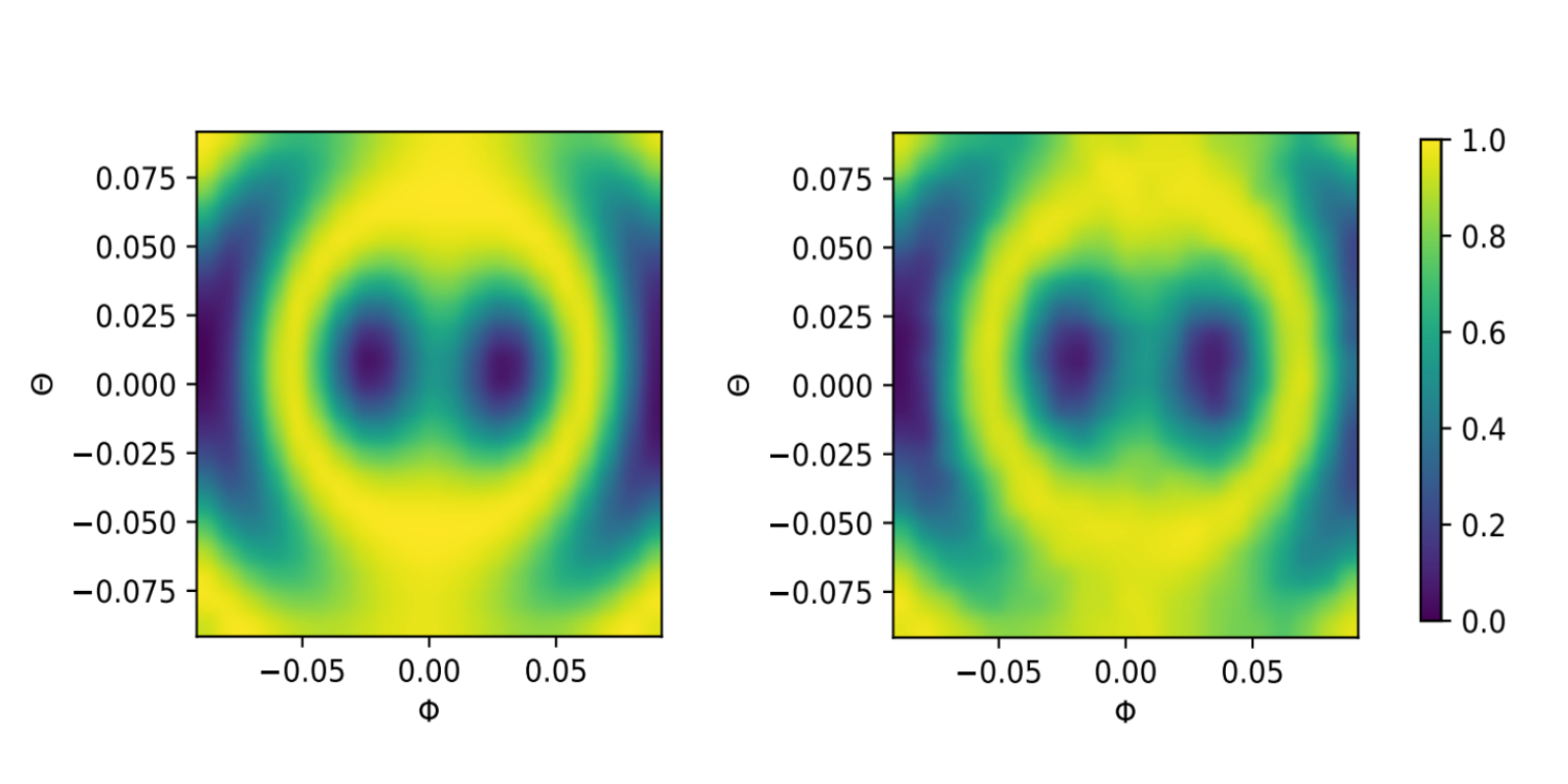
Featured image: Phase space population (probability of measuring $|0rangle$) after applying [$H- X(Theta)- Z(Phi)- H^dagger$]$^{100}$ on $|0rangle$ as a function of $Theta, Phi$ for simulation and experiment. Hidden inverse protocols can offer accurate and cheap single qubit characterization.
Popular summary
► BibTeX data
► References
[1] J. J. Wallman and J. Emerson, Physical Review A 94, 052325 (2016), publisher: American Physical Society.
https://doi.org/10.1103/PhysRevA.94.052325
B. Zhang, S. Majumder, P. H. Leung, S. Crain, Y. Wang, C. Fang, D. M. Debroy, J. Kim, and K. R. Brown, Phys. Rev. Applied 17, 034074 (2022).
https://doi.org/10.1103/PhysRevApplied.17.034074
[3] L. Egan, D. M. Debroy, C. Noel, A. Risinger, D. Zhu, D. Biswas, M. Newman, M. Li, K. R. Brown, M. Cetina, and C. Monroe, Nature 598, 281 (2021).
https://doi.org/10.1038/s41586-021-03928-y
[4] S. Krinner, N. Lacroix, A. Remm, A. Di Paolo, E. Genois, C. Leroux, C. Hellings, S. Lazar, F. Swiadek, J. Herrmann, G. J. Norris, C. K. Andersen, M. Müller, A. Blais, C. Eichler, and A. Wallraff, Nature 605, 669 (2022).
https://doi.org/10.1038/s41586-022-04566-8
[5] C. Ryan-Anderson, J. Bohnet, K. Lee, D. Gresh, A. Hankin, J. Gaebler, D. Francois, A. Chernoguzov, D. Lucchetti, N. Brown, T. Gatterman, S. Halit, K. Gilmore, J. Gerber, B. Neyenhuis, D. Hayes, and R. Stutz, Physical Review X 11, 041058 (2021), publisher: American Physical Society.
https://doi.org/10.1103/PhysRevX.11.041058
[6] R. Blume-Kohout, J. K. Gamble, E. Nielsen, J. Mizrahi, J. D. Sterk, and P. Maunz, arXiv preprint arXiv:1310.4492 (2013).
https://doi.org/10.48550/arXiv.1310.4492
arXiv:1310.4492
[7] B. R. Johnson, M. P. d. Silva, C. A. Ryan, S. Kimmel, J. M. Chow, and T. A. Ohki, New Journal of Physics 17, 113019 (2015), publisher: IOP Publishing.
https://doi.org/10.1088/1367-2630/17/11/113019
[8] E. Nielsen, K. Rudinger, T. Proctor, K. Young, and R. Blume-Kohout, New Journal of Physics 23, 093020 (2021).
https://doi.org/10.1088/1367-2630/ac20b9
[9] P. D. Nation, H. Kang, N. Sundaresan, and J. M. Gambetta, PRX Quantum 2, 040326 (2021).
https://doi.org/10.1103/PRXQuantum.2.040326
[10] Y. Kim, C. J. Wood, T. J. Yoder, S. T. Merkel, J. M. Gambetta, K. Temme, and A. Kandala, Nature Physics 10.1038/s41567-022-01914-3 (2023).
https://doi.org/10.1038/s41567-022-01914-3
[11] E. Peters, A. C. Y. Li, and G. N. Perdue, arXiv:2105.08161 [quant-ph] (2021), arXiv: 2105.08161.
https://doi.org/10.48550/arXiv.2105.08161
arXiv:2105.08161
[12] A. Strikis, D. Qin, Y. Chen, S. C. Benjamin, and Y. Li, PRX Quantum 2, 040330 (2021).
https://doi.org/10.1103/PRXQuantum.2.040330
[13] C. Piveteau, D. Sutter, S. Bravyi, J. M. Gambetta, and K. Temme, Phys. Rev. Lett. 127, 200505 (2021).
https://doi.org/10.1103/PhysRevLett.127.200505
[14] R. LaRose, A. Mari, S. Kaiser, P. J. Karalekas, A. A. Alves, P. Czarnik, M. El Mandouh, M. H. Gordon, Y. Hindy, A. Robertson, P. Thakre, M. Wahl, D. Samuel, R. Mistri, M. Tremblay, N. Gardner, N. T. Stemen, N. Shammah, and W. J. Zeng, Quantum 6, 774 (2022).
https://doi.org/10.22331/q-2022-08-11-774
[15] S. Zhang, Y. Lu, K. Zhang, W. Chen, Y. Li, J.-N. Zhang, and K. Kim, Nature Communications 11, 587 (2020), arXiv: 1905.10135.
https://doi.org/10.1038/s41467-020-14376-z
[16] P. Czarnik, A. Arrasmith, P. J. Coles, and L. Cincio, Quantum 5, 592 (2021).
https://doi.org/10.22331/q-2021-11-26-592
[17] Y. Suzuki, S. Endo, K. Fujii, and Y. Tokunaga, PRX Quantum 3, 010345 (2022).
https://doi.org/10.1103/PRXQuantum.3.010345
[18] K. Temme, S. Bravyi, and J. M. Gambetta, Phys. Rev. Lett. 119, 180509 (2017).
https://doi.org/10.1103/PhysRevLett.119.180509
[19] E. v. d. Berg, Z. K. Minev, A. Kandala, and K. Temme, arXiv preprint arXiv:2201.09866 (2022).
https://doi.org/10.48550/arXiv.2201.09866
arXiv:2201.09866
[20] V. Leyton-Ortega, S. Majumder, and R. C. Pooser, Quantum Science and Technology 8, 014008 (2022).
https://doi.org/10.1088/2058-9565/aca92d
[21] K. Yeter-Aydeniz, B. T. Gard, J. Jakowski, S. Majumder, G. S. Barron, G. Siopsis, T. S. Humble, and R. C. Pooser, Advanced Quantum Technologies 4, 2100012 (2021).
https://doi.org/10.1002/qute.202100012
[22] S. M. Clark, D. Lobser, M. C. Revelle, C. G. Yale, D. Bossert, A. D. Burch, M. N. Chow, C. W. Hogle, M. Ivory, J. Pehr, B. Salzbrenner, D. Stick, W. Sweatt, J. M. Wilson, E. Winrow, and P. Maunz, IEEE Transactions on Quantum Engineering 2, 1 (2021).
https://doi.org/10.1109/TQE.2021.3096480
[23] S. Olmschenk, K. C. Younge, D. L. Moehring, D. N. Matsukevich, P. Maunz, and C. Monroe, Phys. Rev. A 76, 052314 (2007).
https://doi.org/10.1103/PhysRevA.76.052314
[24] P. Maunz, Tech. Rep. SAND2016-0796R 10.2172/1237003 (2016).
https://doi.org/10.2172/1237003
[25] D. Hayes, D. N. Matsukevich, P. Maunz, D. Hucul, Q. Quraishi, S. Olmschenk, W. Campbell, J. Mizrahi, C. Senko, and C. Monroe, Phys. Rev. Lett. 104, 140501 (2010).
https://doi.org/10.1103/PhysRevLett.104.140501
[26] S. Debnath, N. M. Linke, C. Figgatt, K. A. Landsman, K. Wright, and C. Monroe, Nature 536, 63 (2016).
https://doi.org/10.1038/nature18648
[27] P. J. Lee, K.-A. Brickman, L. Deslauriers, P. C. Haljan, L.-M. Duan, and C. Monroe, Journal of Optics B: Quantum and Semiclassical Optics 7, S371 (2005).
https://doi.org/10.1088/1464-4266/7/10/025
[28] L. Deslauriers, P. C. Haljan, P. J. Lee, K.-A. Brickman, B. B. Blinov, M. J. Madsen, and C. Monroe, Phys. Rev. A 70, 043408 (2004).
https://doi.org/10.1103/PhysRevA.70.043408
[29] B. C. A. Morrison, A. J. Landahl, D. S. Lobser, K. M. Rudinger, A. E. Russo, J. W. Van Der Wall, and P. Maunz, in 2020 IEEE International Conference on Quantum Computing and Engineering (QCE) (2020) pp. 402–408.
https://doi.org/10.1109/QCE49297.2020.00056
[30] D. Lobser, J. Goldberg, A. Landahl, P. Maunz, B. Morrison, K. Rudinger, A. Russo, B. Ruzic, D. Stick, J. Van Der Wall, and S. M. Clark, Jaqalpaw A guide to defining pulses and waveforms for jaqal (2021).
https://www.sandia.gov/app/uploads/sites/174/2023/03/JaqalPaw__A_Guide_to_Defining_Pulses_and_Waveforms_for_Jaqal2.pdf
[31] P. Virtanen, R. Gommers, T. E. Oliphant, M. Haberland, T. Reddy, D. Cournapeau, E. Burovski, P. Peterson, W. Weckesser, J. Bright, S. J. van der Walt, M. Brett, J. Wilson, K. J. Millman, N. Mayorov, A. R. J. Nelson, E. Jones, R. Kern, E. Larson, C. J. Carey, İ. Polat, Y. Feng, E. W. Moore, J. VanderPlas, D. Laxalde, J. Perktold, R. Cimrman, I. Henriksen, E. A. Quintero, C. R. Harris, A. M. Archibald, A. H. Ribeiro, F. Pedregosa, P. van Mulbregt, and SciPy 1.0 Contributors, Nature Methods 17, 261 (2020).
https://doi.org/10.1038/s41592-019-0686-2
[32] A. McCaskey, Z. P. Parks, J. Jakowski, S. V. Moore, T. D. Morris, T. S. Humble, and R. C. Pooser, NPJ Quantum Inf 5, 99 (2019).
https://doi.org/10.1038/s41534-019-0209-0
[33] N. C. Rubin, R. Babbush, and J. McClean, New Journal of Physics 20, 053020 (2018).
https://doi.org/10.1088/1367-2630/aab919
[34] D. J. Wineland, C. Monroe, W. M. Itano, D. Leibfried, B. E. King, and D. M. Meekhof, Journal of Research of the National Institute of Standards and Technology 103, 259 (1998).
https://doi.org/10.6028/jres.103.019
Cited by
[1] He-Liang Huang, Xiao-Yue Xu, Chu Guo, Guojing Tian, Shi-Jie Wei, Xiaoming Sun, Wan-Su Bao, and Gui-Lu Long, “Near-term quantum computing techniques: Variational quantum algorithms, error mitigation, circuit compilation, benchmarking and classical simulation”, Science China Physics, Mechanics, and Astronomy 66 5, 250302 (2023).
[2] Zhubing Jia, Shilin Huang, Mingyu Kang, Ke Sun, Robert F. Spivey, Jungsang Kim, and Kenneth R. Brown, “Angle-robust two-qubit gates in a linear ion crystal”, Physical Review A 107 3, 032617 (2023).
[3] Gabriele Cenedese, Giuliano Benenti, and Maria Bondani, “Correcting Coherent Errors by Random Operation on Actual Quantum Hardware”, Entropy 25 2, 324 (2023).
[4] Mingyu Kang, Ye Wang, Chao Fang, Bichen Zhang, Omid Khosravani, Jungsang Kim, and Kenneth R. Brown, “Designing Filter Functions of Frequency-Modulated Pulses for High-Fidelity Two-Qubit Gates in Ion Chains”, Physical Review Applied 19 1, 014014 (2023).
[5] Ashlyn D. Burch, Daniel S. Lobser, Christopher G. Yale, Jay W. Van Der Wall, Oliver G. Maupin, Joshua D. Goldberg, Matthew N. H. Chow, Melissa C. Revelle, and Susan M. Clark, “Batching Circuits to Reduce Compilation in Quantum Control Hardware”, arXiv:2208.00076, (2022).
The above citations are from SAO/NASA ADS (last updated successfully 2023-05-16 13:02:44). The list may be incomplete as not all publishers provide suitable and complete citation data.
On Crossref’s cited-by service no data on citing works was found (last attempt 2023-05-16 13:02:43).
This Paper is published in Quantum under the Creative Commons Attribution 4.0 International (CC BY 4.0) license. Copyright remains with the original copyright holders such as the authors or their institutions.
- SEO Powered Content & PR Distribution. Get Amplified Today.
- PlatoAiStream. Web3 Data Intelligence. Knowledge Amplified. Access Here.
- Minting the Future w Adryenn Ashley. Access Here.
- Buy and Sell Shares in PRE-IPO Companies with PREIPO®. Access Here.
- Source: https://quantum-journal.org/papers/q-2023-05-15-1006/
- :has
- :is
- :not
- ][p
- 1
- 10
- 11
- 12
- 13
- 14
- 15%
- 1998
- 20
- 2013
- 2015
- 2016
- 2017
- 2018
- 2019
- 2020
- 2021
- 2022
- 2023
- 22
- 23
- 24
- 26%
- 27
- 28
- 30
- 66
- 7
- 70
- 8
- 9
- a
- ability
- Able
- above
- ABSTRACT
- access
- accuracy
- accurate
- Act
- actual
- advanced
- affiliations
- After
- algorithm
- algorithms
- All
- American
- Amplification
- an
- and
- Another
- Application
- application specific
- applications
- applied
- Applying
- approach
- ARE
- AS
- astronomy
- author
- authors
- based
- BE
- become
- Benchmark
- benchmarking
- Benjamin
- Bootstrap
- both
- Break
- Bright
- by
- CAN
- caused
- Center
- chains
- characterize
- cheap
- chemical
- chemistry
- chen
- China
- Christopher
- COHERENT
- collections
- comment
- Commons
- Communications
- complete
- computer
- Computer Engineering
- computers
- computing
- Conference
- Connect
- connection
- construct
- contributors
- control
- copyright
- coupled
- crain
- Crystal
- Currently
- Daniel
- data
- defining
- demonstrate
- designing
- details
- Determine
- Development
- Devices
- discuss
- dominant
- Duke
- duke university
- during
- e
- enables
- enabling
- Engineering
- error
- Errors
- examine
- execution
- exhibit
- experiment
- few
- filter
- Find
- First
- fitting
- focused
- followed
- For
- found
- from
- function
- functions
- further
- Gamble
- Gates
- generations
- guide
- Hardware
- harvard
- help
- here
- Hidden
- holders
- How
- HTTPS
- i
- idea
- IEEE
- image
- important
- improve
- improvement
- in
- information
- Institute
- institutions
- Intentional
- interesting
- International
- ITS
- JavaScript
- Johnson
- journal
- Kim
- King
- known
- laboratory
- landscape
- Last
- Leave
- Led
- Lee
- Level
- Li
- License
- like
- List
- Long
- loss
- lower
- matthew
- max-width
- May..
- mcclean
- meaning
- measurements
- measuring
- mechanics
- method
- Methodology
- methods
- Mexico
- Mitigate
- mitigating
- mitigation
- model
- models
- Month
- most
- namely
- nation
- National
- native
- Nature
- Near
- New
- no
- Noise
- non-native
- number
- oak
- Oak Ridge National Laboratory
- of
- offer
- on
- open
- operation
- Operations
- optics
- or
- order
- original
- outline
- Outperform
- over
- Paolo
- Paper
- past
- Perform
- performance
- Peterson
- phase
- physical
- Physics
- plato
- Plato Data Intelligence
- PlatoData
- population
- powerful
- precise
- Prior
- problems
- Processor
- protocols
- provide
- provides
- published
- publisher
- publishers
- Publishing
- purely
- Quantum
- quantum algorithms
- Quantum Computer
- quantum computers
- quantum computing
- quantum information
- Qubit
- qubits
- random
- Randomized
- realistic
- reduce
- references
- rely
- remains
- repeatable
- research
- Results
- review
- ROBERT
- Ryan
- s
- same
- schemes
- Science
- Science and Technology
- Section
- see
- Series
- several
- show
- sign
- silva
- Simple
- simulation
- single
- small
- Society
- Source
- Sources
- Space
- specific
- standards
- subsequent
- Successfully
- such
- sufficient
- suitable
- Sun
- support
- Susan
- system
- tech
- techniques
- Technologies
- Technology
- that
- The
- their
- then
- These
- Theta
- they
- this
- those
- Through
- time
- Title
- to
- tool
- Transactions
- type
- typical
- under
- university
- updated
- URL
- use
- using
- various
- very
- via
- volume
- W
- Wall
- want
- was
- we
- WELL
- whether
- which
- while
- Wilson
- with
- within
- wood
- works
- Wright
- X
- Ye
- year
- years
- young
- zephyrnet


